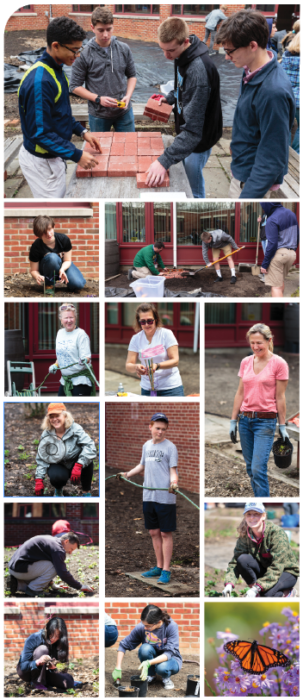Last spring, the main office courtyard of Horace Greeley High School was transformed into the new Greeley Native Plant Learning Garden (GNPLG). More than a dozen students, faculty and PTA parent volunteers planted more than 3,000 native plants in what used to be a neglected area of turf grass surrounded by a hedge of burning bush, a non-native invasive species.

Native plants are those that occur naturally in a region, having co-evolved over a period of time with other plants, insects and animal species, developing complex interdependent relationships. They instill a sense of place and emotional connection to our environment. Here in the temperate deciduous forests of the Northeast, native species include trees such as sugar maples and oaks, grasses such as little bluestem and purple love grass and herbaceous perennials such as violets, goldenrods and asters.
Unfortunately, many native woodland species, particularly flowers, have been eradicated because of the accidental introduction of non-native invasive species. Traditionally chosen for ornamental planting on our suburban landscape, these species, such as barberry and pachysandra have escaped cultivation, taking over our woodlands and right-of-ways. Oriental bittersweet is just one of the many invasive vines you see along the Saw Mill River Parkway that has over run native trees and shrubs. Ornamental species were chosen precisely because they did not have any natural insect predators or diseases and this has allowed them to outcompete our native plants, upon which a whole host of pollinators and wildlife depend. Non-native plants in general support far fewer native insects and birds than our native ones do. Add an overabundant deer population, which browse on saplings and early spring bloomers, and the situation seems dire.
The good news, however, is that if you plant it, they will come and come indeed they did to GNPLG. By the fall, GNPLG was abuzz with hundreds of pollinators, our native bees, flies and butterflies. Pollinators move pollen from one flower to another flower of the same species, helping plants to produce fertile seeds and fruit and are responsible for one out of every three bites of food we eat. The pervasive use of pesticide coupled with habitat loss has led to the decline of many pollinators, including our native bumblebees, which are considered threatened in North America. Monarch butterfly populations have been steadily declining and are down for a second year in a row, according to a report by Monarch Joint Venture, an organization of more than 70 academic, business and NGO partners dedicated to conservation of monarch migration. But both were present in abundance at GNPLG, happily nectaring and foraging on orange butterfly weed, smooth aster and goldenrod.
Migrating birds also stopped by GNPLG to feast on the berries of the mature dogwood planted in the courtyard in the late 70’s. When nesting in the spring, these birds rely on caterpillars and insect larvae (think soft, yummy protein) to feed their young. The majority of insect larvae and caterpillars are specialists dependent on native plant species for food. A few holes in your leaves? Not to worry, the birds will find the culprit. According to Doug Tallamy, entomologist and author of Bringing Nature Home, it takes an incredible 6,000-9,000 caterpillars to make just one clutch of chickadees, which is just a tiny bird, weighing less than three pennies in your pocket. No native plants, no caterpillars. No caterpillars, no chickadees. And who doesn’t love a chickadee?
“The garden at Greeley is an important tool in helping students learn about the many benefits of native plants,” says Carol Capobianco, director of The Native Plant Center at Westchester Community College. “Native plants provide valuable sources of food and shelter for wildlife and define a local sense of place. And because they are adapted to the local weather conditions, soils, and predators, they require less maintenance and no pesticides or fertilizers. Plus, they are beautiful.”
Not only is the GNPLG a beautiful place for students and faculty to relax on a break, it also offers a wide range of place-based and project-based learning from botany and ecology to photography and art. Students from Greeley’s Students and Teachers for Our Planet (STOP) Committee along with members of the Greeley Garden PTA and the Chappaqua Garden Club plan to manage the garden ensuring its success going forward.
Join STOP, Chappaqua Garden Club and the Greeley Garden PTA for an open house of the GNPLG on May 17, 2018 (rain date May 22) from 12 p.m. – 4 p.m. Native plant experts and students will be on hand to answer questions and students from the Greeley Chamber Orchestra will be performing. Come check it out!
Top 5 Things To Consider When Adding Natives to Your Landscape
Reduce Your Lawn: A reduced lawn saves both time and money. Lawns require a tremendous amount of resources including water, pesticides and fertilizers, not to mention weekly mowing. Expand existing garden beds and shrub areas by adding or encouraging low maintenance native groundcovers, such as violets, ferns, goldenrod and asters.
Leave Leaves Alone: Leaves provide a natural source of soil nutrients as they break down, as well as habitat for overwintering beneficial insects and other pollinators. Use a mulching mower to mulch leaves directly in your lawn and let them overwinter in garden beds and under shrubs to build healthy soil. Instruct your landscaper not to use a leaf blower in those areas. Wait until late winter to cut back perennials, allowing birds and insects to take advantage of seed heads and cover.
Green Mulch: Let the plants work for you! Add native groundcovers under shrubs and in perennial beds to act as a living mulch, suppressing weeds and moderating soil temperature. Great deer resistant choices include golden groundsel (Packera aurea) which is evergreen, produces yellow flowers in early spring and grows well in both sun and shade and native grasses such as sedges (Carex spp.) and ferns. Hay-scented fern even grows in full sun!
Oh Deer!: There are many choices of native trees and shrubs that deer typically do not browse that can be substituted for non-native ornamental plants. American holly (Ilex opaca), Blackhaw viburnum (Viburnum prunifolium) and Viburnum nudum ‘Brandywine’ and ‘Winterthur’ are just a few that provide berries for birds and cover in winter.
Succession of Bloom: Choose hardy, deer resistant plants that bloom all season long and plant them in groups of 3s and 5s. Columbine flowers (Aquilegia canadensis) open just as the ruby-throated hummingbird returns in early spring. In summer, orange butterfly weed (Asclepias tuberosa) and swamp milkweed (Asclepias incarnata) host monarch caterpillars. Mountain mint (Pycnanthemum spp.) is a pollinator magnet and blue mistflower (Conoclinium coelestinum) is covered with bright purple flowers (and butterflies!) in late fall.
